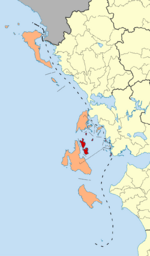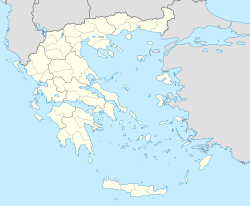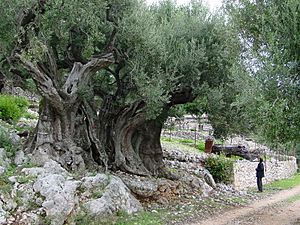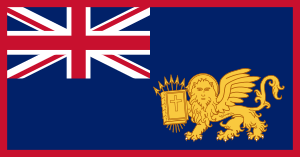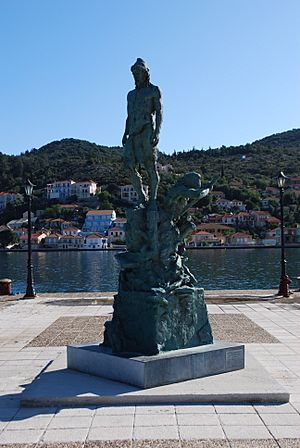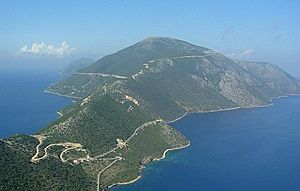Ithaca (island) facts for kids
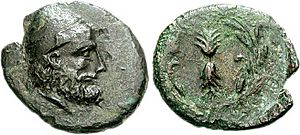
Ithaca, also known as Ithaki or Ithaka, is a beautiful Greek island. It's located in the Ionian Sea, near the larger island of Kefalonia. This island is famous for being the home of Odysseus, a legendary hero from ancient Greek stories.
Ithaca's main island is about 96 square kilometers (37 square miles) in size. In 2021, about 2,862 people lived there. It is the second-smallest of the seven main Ionian Islands. Ithaca is its own special area in Greece, and its capital city is Vathy.
Contents
Island Names: Ithaca Through Time
Even though the name Ithaca has stayed the same for a very long time, people have called the island by other names too. These names changed depending on the time period and who was ruling.
Some past names include:
- Val di Compare (Valley of the Bestman)
- Piccola (Small) Cephallonia
- Anticephallonia (from the Middle Ages to early Venetian times)
- Ithaki nisos (Greek for island)
- Thrakoniso, Thakou, Thiakou (during the Byzantine period)
- Thiaki (Byzantine and before the Venetian period)
- Teaki (during the Venetian period)
- Fiaki (during the Ottoman period)
Ithaca's Long History
Ithaca has been lived on for a very long time, since about 4000 BC. It might have been an important city during the Mycenaean period. This was when the legendary hero Odysseus ruled his small kingdom from here.
Early Rulers and Empires
The Romans took control of the island in the 2nd century BC. After that, it became part of the Byzantine Empire. In the 13th century, the Normans ruled Ithaca. Then, after a short time under Turkish rule, it became part of the Venetian lands.
Changing Hands: French and British Rule
In 1797, France took over Ithaca. But soon, in 1798, a combined force from Russia and Turkey freed it. Ithaca then became part of the Septinsular Republic, a group of islands protected by Russia and the Ottoman Empire.
In 1807, France took control again. However, the British took the island in 1809 during the Napoleonic Wars. From 1815, Ithaca was part of the United States of the Ionian Islands. This was a British protectorate, meaning the British protected and influenced it.
Joining Greece
By 1830, the people of Ithaca wanted to join the newly formed country of Greece. Finally, in 1864, Ithaca and the other six Ionian islands were given to Greece. This was a friendly gesture to Greece's new king, George I.
First Settlers of Ithaca
We don't know exactly where the first people on Ithaca came from. They arrived during the late Neolithic period (around 4000–3000 BC). We know they lived here because of old buildings, walls, and roads found from that time. Life continued on the island through the Early Hellenic era (3000–2000 BC).
Mycenaean Era: The Time of Odysseus
During the Mycenaean period (1600–1100 BC), Ithaca became very important. Based on the famous story of the Odyssey, many believe Ithaca was the capital of a powerful kingdom. This kingdom included the nearby lands. The people of Ithaca were known as great sailors and explorers. They traveled far across the Mediterranean Sea.
The epic poems by Homer, the Iliad and the Odyssey, tell us about Ithaca in the Bronze Age. These poems were likely written around 9th or 8th centuries BC. They describe the hero Odysseus and his rule over Ithaca. These stories give us clues about the way of life and geography of that time. After the Mycenaean period, Ithaca became less powerful. It then came under the control of larger nearby islands.
Ancient Greek Times
During the ancient Hellenic period (800–180 BC), people continued to live independently on the island. In the southern part, a town called Alalcomenae was built. Many important historical items have been found from this time. These include coins with the name Ithaca and the image of Odysseus. This suggests that the island governed itself back then.
Middle Ages: Pirates and New Rulers

Over time, different groups conquered Ithaca. This caused the island's population to change a lot. During the Middle Ages, the number of people living on the island went down. This was because of constant pirate attacks. People had to move to the mountains to be safe.
Ithaca often shared its fate with its larger neighbor, Cephalonia. In 1185, Cephalonia and Zakynthos were captured by Margaritone of Brindisi. Ithaca was likely taken then too. Later, Ithaca came under the rule of the Orsini family. Then, it was given to the Tocco family in 1357. Under the Tocco family, we start to see more specific records about Ithaca.
Ottoman and Venetian Eras
In 1479, forces from the Ottoman Empire arrived. Many people fled the island, fearing the new rulers. Those who stayed hid in the mountains to avoid pirates. For a few years, the Turks, the Tocco family, and the Venetians all claimed the islands.
From 1484 to 1499, the Ottoman Empire controlled the islands. But the Venetians had a strong navy. In 1499, a war began between the Venetians and the Turks. The Venetians and their Spanish allies won. From 1500 onwards, the Venetians ruled Ithaca.
At this time, Ithaca was almost empty. The Venetians offered special benefits to people from nearby islands and the mainland to encourage them to move there. Many people from Crete also arrived, especially after the Siege of Candia. Important families like the Karavia family settled on the island. They became involved in profitable sea trade and even piracy against the Ottomans. Ithaca remained under Venetian control for the next few centuries.
French Rule and New Ideas
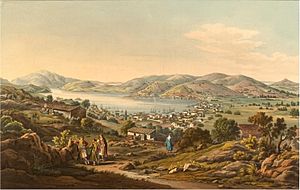
After the French Revolution, the Ionian Islands, including Ithaca, came under the rule of the First French Republic (1797–1798). Ithaca became an important center for the French. At first, people welcomed the French because they improved the government. But later, the high taxes made the people unhappy.
During this short period, new ideas about government and society greatly influenced the islanders. In late 1798, Russia and Turkey, who were allies, took over from the French. Corfu became the capital of the Septinsular Republic. Ithaca had one representative in its government.
The ships from Ithaca did very well during this time. They were allowed to carry goods to ports in the Black Sea. In 1807, the Ionian Islands came under French rule again. The French quickly started building a fort in Vathy to prepare for battles with the powerful British navy.
British Rule and Modern Times
In 1809, Great Britain blocked the Ionian Islands as part of the Napoleonic Wars. In September, they raised the British flag over the castle of Zakynthos. Cephalonia and Ithaca soon surrendered. The British set up temporary governments.
The Treaty of Paris (1815) officially made the United States of the Ionian Islands a British protectorate. This meant Britain protected and influenced the islands.
Later, Greek nationalist groups began to form. They wanted to join Greece, especially after Greece gained independence from the Ottoman Empire. There were protests and even small fights with the British army. This led to more freedom, like freedom of the press. The people of Ithaca openly demanded to join Greece.
Many important citizens from Ithaca secretly joined the "Philiki Etairia". This group helped organize the Greek Revolution of 1821 against Turkish rule. Greek fighters also found safety on Ithaca. People from Ithaca also played a big part in battles like the siege of Messolongi. Finally, in 1864, Ithaca became part of the Greek Kingdom along with the other Ionian islands.
Ithaca: Home of the Hero Odysseus
For thousands of years, people have believed that Ithaca is the home of the mythical hero Odysseus. In Homer's famous poem, the Odyssey, Ithaca is described like this:
"...dwell in clear-seen Ithaca, wherein is a mountain, Neriton, covered with waving forests, conspicuous from afar; and round it lie many isles hard by one another, Dulichium, and Same, and wooded Zacynthus. Ithaca itself lies close in to the mainland the furthest toward the gloom, but the others lie apart toward the Dawn and the sun—a rugged isle, but a good nurse of young men"
Sometimes, people have argued that this description doesn't quite match modern Ithaca. For example, the poem calls Ithaca "low-lying," but the island is actually mountainous. Also, it says Ithaca is "farthest out to sea, towards the sunset," but Kefalonia is west of Ithaca.
However, the Greek geographer Strabo, who lived in the 1st century AD, said that modern Ithaca was indeed Homer's Ithaca. He explained that "low-lying" could mean "close to the mainland." He also said "farthest out to sea, towards the sunset" meant "farthest of all towards the north." Strabo believed that Same was modern Kefalonia.
Despite these small differences, people in ancient Roman times always believed that the island we call Ithaca today was Odysseus's home. Coins from Ithaca often show Odysseus. An old inscription from the 3rd century BC even mentions a shrine for Odysseus and games called the Odysseia.
In 2010, Greek archaeologists found the remains of an 8th-century BC palace on Ithaca. This led to excitement that it might have been Odysseus's palace! Today, most experts agree that modern Ithaca is the same island as Homer's Ithaca. They think any small differences in the description are just poetic ways of telling the story.
Ithaca's Geography
Ithaca is located east of the northeast coast of Cephalonia. A narrow body of water called the Strait of Ithaca separates them. The island covers about 117.8 square kilometers (45.5 square miles) and has about 100 kilometers (62 miles) of coastline.
The main island stretches from north to south. It is about 23 kilometers (14 miles) long and up to 6 kilometers (3.7 miles) wide. Ithaca is made of two parts, almost equal in size. These parts are connected by a very narrow strip of land called the isthmus of Aetos (Eagle), which is only about 600 meters (2,000 feet) wide.
These two parts surround the bay of Molos. The southern part of this bay is where the harbor of Vathy is located. Vathy is the capital and largest town on the island. The second largest village is Stavros, in the northern part of the island.
Lazaretto Islet, also called Island of The Saviour, protects the harbor. It has a church and the remains of an old prison.
Ithaca has several capes, which are points of land sticking out into the sea. These include Exogi (westernmost), Melissa (north), Mavronos, Agios Ilias, Schinous, Sarakiniko, and Agios Ioannis (east), and Agiou Andreou (south). The island also has many beautiful bays like Afales Bay, Frikes, Kioni Bay, Molos Gulf, Ormos Gulf, and Sarakiniko Bay.
The tallest mountain on Ithaca is Nirito, in the northern part, standing at 806 meters (2,644 feet). Merovigli is another tall mountain in the south, at 669 meters (2,195 feet).
How Ithaca is Governed
The island of Ithaca is part of the regional unit of Ithaca. This unit is part of the larger Ionian Islands region in Greece. The only local government area (municipality) in this regional unit is Ithaca itself. Ithaca is the only island with people living on it in this municipality, but there are also several smaller, uninhabited islets.
Villages and Communities
Here are some of the villages and communities on Ithaca:
- Aetos
- Afales
- Agios Ioannis
- Agia Saranta
- Anogi
- Exogi
- Frikes
- Kalivia
- Kathara
- Kioni
- Kolieri
- Lachos
- Lefki
- Marmaka
- Perachori
- Piso Aetos
- Platrithia
- Rachi
- Stavros
- Vathy
Famous People from Ithaca
Many notable people have connections to Ithaca:
- Odysseus (13th century BC): The legendary Greek king of Ithaca and the main character of Homer's epic poem, the Odyssey.
- St. Joachim Papoulakis (1786–1868): A monk and an Orthodox Saint.
- Nikolaos Galatis (1792-1819): An important figure before the Greek War of Independence and a member of the Filiki Eteria (a secret society that helped organize the revolution).
- Odysseas Androutsos (1788–1825): A brave fighter in the Greek War of Independence.
- Dionysius Rodotheatos (1849-1892): A well-known composer.
- Platon Drakoulis (1858–1934): A philosopher, writer, and politician.
- Lorentzos Mavilis (1860–1912): A famous poet.
- Ioannis Metaxas (1871–1941): A general and leader of Greece. His family came from Cephalonia.
- Panagis Lekatsas (1911–1970): A writer and journalist.
- Evgenios Karavias (1752 - 1821): An important religious leader, scholar, and martyr.
- Vasilios Karavias (1733 - 1830): A military man and one of the first to start the Greek revolution in Moldo-Wallachia in 1821.
- Karavias Ippokrates (1866 - 1954): A lawyer, journalist, and writer.
- Karavias Dimitrios (Misolitros): A fighter in the 1821 Greek Revolution against the Ottomans.



